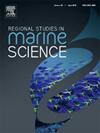巴西南部河口的微塑料:环境、形态和季节变化之间的相互作用
IF 2.4
4区 环境科学与生态学
Q3 ECOLOGY
引用次数: 0
摘要
河口是生物多样性丰富的复杂环境,由于可能影响这些颗粒运动的多种变量,因此了解微塑料的分布和发生具有挑战性。在此基础上,本研究评估了不同环境因素对Tramandaí河口地表水微塑料分布和迁移的影响。L−1平均出现14.21 ± 3.07个项目,主要是尺寸小于500 µm的白色/透明纤维。聚乙烯和聚丙烯为优势聚合物,平均羰基指数(CI)为0.77 ± 0.41。结果表明,少雨期可以减少研究口地表水中微塑料的出现,但增加白色或无色颗粒和碎片的优势。此外,人为活动和水深影响了地表水颗粒的发生和形态。此外,逐渐靠近海洋减少了蓝色微塑料的出现,增加了较小颗粒的丰度。最后,潮汐的变化只直接影响河口点,影响颗粒的发生和形状。因此,研究结果表明,有几个因素干扰了Tramandaí河流域微塑料的丰度和特征。河口点受变量影响最大,凸显了环境的复杂性。此外,还强调了评估采样地点固有方面和季节性因素的重要性。本文章由计算机程序翻译,如有差异,请以英文原文为准。
Microplastics in the Southern Brazilian estuary: Interactions between environment, morphology, and seasonal variation
Estuaries are complex environments rich in biodiversity, making it challenging to understand the distribution and occurrence of microplastics due to the multiple variables that can influence the movement of these particles. Based on this, this study evaluated the influence of different environmental aspects on the distribution and transport of microplastics in the surface waters of the Tramandaí River estuary. An average occurrence of 14.21 ± 3.07 items L−1 was identified, with a predominance of white/transparent fibers smaller than 500 µm in size. PE and PP were the predominant polymers with an average carbonyl index (CI) of 0.77 ± 0.41. From the results, it was observed that periods with little rainfall can decrease the occurrence of microplastics in the surface water of the studied estuary but increase the predominance of white or colorless particles and fragments. Additionally, anthropogenic activity and water depth influenced the occurrence and form of particles in the surface waters. Furthermore, the progressive approach to the sea decreased the occurrence of blue microplastics and increased the abundance of smaller particles. Finally, the change in tides directly impacted only the estuary point, influencing the occurrence and shape of the particles. Thus, the results demonstrated that several factors interfered with the abundance and characteristics of the microplastics found in the Tramandaí River basin. The estuary point was influenced by the largest number of variables, highlighting the complexity of these environments. Additionally, the importance of evaluating not only aspects intrinsic to the sampling site but also seasonal factors was emphasized.
求助全文
通过发布文献求助,成功后即可免费获取论文全文。
去求助
来源期刊

Regional Studies in Marine Science
Agricultural and Biological Sciences-Ecology, Evolution, Behavior and Systematics
CiteScore
3.90
自引率
4.80%
发文量
336
审稿时长
69 days
期刊介绍:
REGIONAL STUDIES IN MARINE SCIENCE will publish scientifically sound papers on regional aspects of maritime and marine resources in estuaries, coastal zones, continental shelf, the seas and oceans.
 求助内容:
求助内容: 应助结果提醒方式:
应助结果提醒方式:


